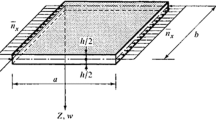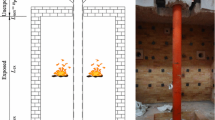Abstract
Buckling is a critical issue for structural stability in structural design. In most of the buckling analyses, applied loads, structural and material properties are considered certain. However, in reality, these parameters are uncertain. Therefore, a prognostic solution is necessary and uncertainties have to be considered. Fuzzy logic algorithms can be a solution to generate more dependable results. This study investigates the material uncertainties on column design and proposes an uncertainty model for critical column buckling reinforced concrete buildings. Fuzzy logic algorithm was employed in the study. Lower and upper bounds of elastic modulus representing material properties were defined to take uncertainties into account. The results show that uncertainties play an important role in stability analyses and should be considered in the design. The proposed approach is applicable to both future numerical and experimental researches. According to the study results, it is seen that, calculated buckling load values are stayed in lower and upper bounds while the load values are different for same concrete strength values by using different code formula.
Similar content being viewed by others
References
ACI 318-95 1996 Building code requirements for structural concrete, ACI Manual of Concrete Practice Part 3: Use of concrete in Buildings Design, Specifications, and Related Topics Detroit, Michigan
Akkurt S, Ozdemir S, Tayfur G, Akyol B 2003 The use of GA-ANNs in the modelling of compressive strength of cement mortar. Cement and Concrete Research 33: 973–979
Aristizabal-Ochoa J D 1997 Braced, partially braced and unbraced frames: Classical approach. J. Struct. Eng. 123(6): 799–807
Baalbaki W, Benmokrane B, Chaallal O, Aitcin PC 1991 Influence of coarse aggregate on elastic properties on high performance concrete. ACI Materials Journal 88(5): 499–503
Battini M, Pacoste C 2002 Co-rotational beam elements with warping effects in instability problems. Comput. Methods Applied Mech. Eng. 191: 1755–1789
Ben-Haim Y, Elishakoff I 1990 Convex models of uncertainty in applied mechanics. Amsterdam: Elsevier
Biondini F, Bontempi F, Malerba G P 2004 Fuzzy reliability analysis of concrete structures. Computers and Structures 82(13): 1033–1052
Bratina S, Saje M, Planinc I 2004 On materially and geometrically nonlinear analysis of reinforced concrete planar frames. Int. J. of Solids and Struct. 41: 7181–7207
Cakiroglu A 1962 Buckling analysis of multi-storey frames. In: Proc. of technical conference of Turkish Civil Engineers (in Turkish)
CEB-FIB 1993 Model Code. Bull. D’information CEB, 213/214, Lausanne
Cheong-Siat-Moy F 1999 An improved K-factor formula. J. Struct. Eng. 125(2): 169–74
Demir F 2005 A new way prediction of modulus of elasticity of normal and high strength concrete-fuzzy logic. Cement and Concrete Research 35(8): 1531–1538
Demir F, Korkmaz K A 2008 Prediction of lower and upper bounds of elastic modulus of high strength concrete. Construction and Building Material 22: 1385–1393
Elishakoff I 1999 Whys and hows in uncertainty modeling, probability, fuzziness and anti-optimization. New York: Springer-Verlag, Wien
Faison H, Comartin C D, Elwood K 2004 Reinforced concrete moment frame building without seismic details. Earthquake Engineering Research Institute (EERI) and International Association for Earthquake Engineering (IAEE) Housing Report 111.
GBJ11-89 1994 Chinese Design Code, National standard of the People’s Republic of China, Chinese code for seismic design of buildings. Beijing: NewWorld Press
GDC 2000 Greek Design Code, Greek National Code Center, Athens, Greece
Gesoglu M, Guneyisi E, Ozturan T 2002, Effects of end conditions on compressive strength and static elastic modulus of very high strength concrete. Cement and Concrete Research 32(10): 1545–1550
Girgin K, Ozmen G 2007 Simplified procedure for determining buckling loads of three-dimensional framed structures. Eng. Struct. 29(9): 2344–2352
Girgin K, Ozmen G, Orakdogen E 2006 Buckling lengths of irregular frame columns. J. Constructional Steel Research 62(6): 605–613
IDC 2003 Italian Design Code, IDC3274, Come Modificato Dall’OPCM 3431. Italy: Public and Health Ministry
Ke-Ru W, Bing C, Wu Y, Dong Z 2001 Effect of coarse aggregate type on mechanical properties of high-performance concrete. Cement and Concrete Research 31(10): 1421–1425
Kim Y M, Kim C K, Hong S G 2006 Fuzzy based state assessment for reinforced concrete building structures. Eng. Struct. 28(9): 1286–1297
Korkmaz K A, Demir F, Tekeli H 2008 Elastic modulus effects of concrete on buckling of R/C Buildings. 12th International Conference on Computing in Civil and Building Engineering, October 16–18, Beijing, China
Korkmaz K A, Tekeli H, Demir F 2009 Determination of elastic moduli effects on storey-drifts by fuzzy logic algorithm. Civil Engineering and Environmental Systems 26: 249–262
Kosko B 1992 Neural networks and fuzzy systems. Englewood Cliffs (NJ): Prentice Hall
LeMessurier W J 1977 A practical method of second-order analysis, 2: Rigid frames. Eng. J. AISC 14(2): 49–67
Lui E M 1992 A novel approach for K factor determination. Engineering Journal, AISC 29(4): 150–159
Mata P, Barbat A H, Oller S, Boroschek R 2008 Constitutive and geometric nonlinear models for the seismic analysis of RC structures with energy dissipators. Architectural Computational Methods Engineering 15: 489–539
Moller B, Beer M 2004 Fuzzy randomness: Uncertainty in civil engineering and computational mechanics. NY: Springer
Moller B, Graf W, Beer M 2003 Safety assessment of structures in view of fuzzy randomness. Computers and Structures 81(15): 1567–1582
Noor A K, Starnes J R, Peters J M 2001 Uncertainty analysis of stiffened composite panels. Composite Structures 51: 139–158
N S 1992 Norwegian Council for Building Standardization. Concrete Structures Design Rules NS 3473 E, Stockholm, Norway
Ozmen G, Girgin K 2005 Buckling lengths of unbraced multi-storey frame columns. Struct. Eng. and Mech. 19(1): 55–71
Pantelides C P, Booth B C 1999 Computer-aided design of optimal structures with uncertainty. Computers and Structures 74(3): 293–307
Petryna Y S, Kratzig W B 2005 Computational framework for long-term reliability analysis of RC structures. Comput. Methods Appl. Mech. Eng. 194: 1619–1639
Petryna Y S, Pfanner D, Stangenberg F, Kratzig W B 2002 Reliability of reinforced concrete structures under fatigue. Reliability Engineering and System Safety 77: 253–261
Puklicky L, Kala Z 2009 Application of uncertainty analysis to stability problems of steel-concrete structural members. Eng. Struct. and Technol. 1(1): 44–49
Shannag M J 2002 High strength concrete containing natural pozzolan and silica fume. Cement and Concrete Composites 22: 399–402
Stevens L K 1967 Elastic stability of practical multi-storey frames. Proceedings of the Institute of Civil Engineers 36: 99–117
TDC 2007 Turkish Design Code, Turkish Chamber of Civil Engineering, Izmir, Turkey (in Turkish)
TS 500 2000 Turkish Standard, Restrictions for Design and Construction of R/C Structures, Ankara, Turkey (in Turkish)
UBC 1997 Uniform Building Code, International Conference of Building Officials. Vol.2, Whittier, CA, USA
Wee T H, Chin M S, Mansur M A 1994 Stress–strain relationship of high-strength concrete in compression. J. Materials in Civil Eng. 8(2): 70–76
Yura J A 1971 Effective length of columns in unbraced frames. Eng. J. AISC 8(2): 37–42
Author information
Authors and Affiliations
Corresponding author
Rights and permissions
About this article
Cite this article
KORKMAZ, K.A., DEMIR, F. & TEKELI, H. Uncertainty modelling of critical column buckling for reinforced concrete buildings. Sadhana 36, 267–280 (2011). https://doi.org/10.1007/s12046-011-0013-9
Received:
Revised:
Accepted:
Published:
Issue Date:
DOI: https://doi.org/10.1007/s12046-011-0013-9




